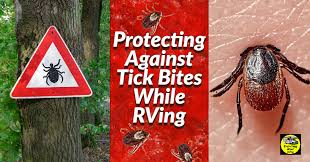Whatever your approach and the you apply the DEET is applied it is possible that you will be at the mercy of an itch from a tick. The amount of tick-borne illnesses within the U.S. mostly Lyme disease -has nearly tripled over the past decade according to a 2017 report from the Centers for Disease Control and Prevention (CDC).
Although it’s frightening to find a tiny creature of brown or black on your body, there’s no reason to be worried in the event that you’ve been attacked by ticks.
This is a step-by-step guide for the treatment of the bite of a tick.
1. Relax
It’s normal for you to freak out when you spot ticks on you. However, the likelihood of contracting an infection caused by ticks is quite low, as most ticks don’t carry any disease, according to Michael Cameron, MD as an assistant dermatologist in Mount Sinai Hospital in New York City.
Since the deer tick which transmits Lyme disease is fed for more than 36 hours before transmitting an infection, likelihood of contracting Lyme disease as a result of a tick bite is 1.2 or 1.4 percent, regardless of whether you reside in a region of the nation in which the disease is prevalent as per The UptoDate.
2. Remove the Tick
The CDC provides specific instructions regarding how to remove ticks, as if you don’t do it in the right method, you could result in the tick’s components to remain in the skin.
Here’s how:
- Use tweezers that have fine tips to grip the tick. Make sure to grab closely as you possibly can to get close enough.
- Make sure you pull upwards with constant and even pressure. Be careful not to twist or jerk your tick as this could cause a portion of it to split off.
Do not make use of the following:
- A smoldering match or cigarettes
- Nail polish
- Petroleum jelly
- Liquid soap
- Kerosene
Although they’re all well-known home remedies, they aren’t able to eliminate the ticks the tick, according to Michael Zimring, MD director at The Center for Wilderness and Travel Medicine at Mercy Medical Center in Baltimore and co-author of the book Healthy Travel.
Actually, using any of these treatments could make things worse since it could cause irritation to the tick and trigger it to leak more fluid from the bite.
3. Clean the Bite
Once you have removed the tick, scrub the area of the bite with soap or rubbing alcohol. water.
4. Take a Look at the Tick
You’ll need a few details to discuss with your doctor, as per Current:
Coloring
- Brown ticks that are the in the size of an poppy seed the pencil eraser are deer ticks. They transmit the bacteria which causes Lyme disease and other tick-borne illnesses such as Babesiosis.
- Brown ticks that have white collars are likely to be dog ticks. They may carry a more serious tick-borne disease known as Rocky Mountain spotted fever.
- A black or brown tick with a white streak in its back is an Lone Star tick. It may spread Southern tick-associated rash illness (STARI) which can cause an rash that is similar to those you encounter with Lyme disease.
Size
- The tick’s size was smaller and simple to get rid of It’s a good indication that it wasn’t carrying Lyme disease or another infection since it hadn’t yet begun an eating regimen.
- In the event that the tick appeared larger with a globular form It’s had as a blood meal and it’s more likely of transmitting the tick-borne disease. It should have eaten over a period of at least 36 hours in order to transmit Lyme disease. However, it’s not yet known the length of time it has to remain attached in order to spread other diseases.
5. Flush the Tick Down the Toilet
There’s no need to take it to your physician Dr. Cameron says. The laboratories that test ticks do not have to adhere to the same standards for quality as labs used by hospitals or clinics, as per the CDC.
“A positive test can also be misleading, since even if a tick contains a bacteria, that doesn’t mean you’ve been infected by it,” Dr. Zimring says.
6. Call Your Doctor
In certain circumstances your doctor will decide to administer an anti-infective dose of the antibiotic doxycycline when you meet the following requirements in accordance with the Infectious Disease Society of America:
- It was probably an animal tick.
- The tick is thought to have been in the area for at least 36 hours (based on how engorged a tick appears, or the amount of time since exposure to the outdoors).
- It’s within 72hrs of the removal of the tick.
- The bite happened in a region with an extremely high rate of Lyme disease, such as Pennsylvania, New York, New Jersey, Maine, New Hampshire or Wisconsin. (You can find the state you reside in by clicking here.)
If you meet the above requirements the doctor may provide you with only a single dose of 200 mg of Doxycycline.
7. Watch for Symptoms
If you’re not in the criteria to be treated promptly, then you’ll be required to monitor for signs of Lyme disease in the coming 30 days. There’s no need to undergo a test for Lyme disease.
“Antibodies can take several weeks to develop, so you may test negative if it’s a very recent infection,” Dr. Cameron points out.
Furthermore in the event that you’ve experienced Lyme disease before, the antibodies may persist within your bloodstream for months, or even for years. Therefore, an positive test does not necessarily indicate that you’re sick, says Dr. Zimring.
Instead, be on the lookout for signs of a itchy rash. It is estimated that the 80-percent mark of those suffering from Lyme disease suffer from the rash, which is also called erythema migrans.
Although most times, people think about it as the “classic” bulls-eye rash when it is Lyme condition, this could appear as simple red rash Dr. Cameron says. Common spots include around your ears, or hairline under your arms in your bellybutton, around your waist between your legs or at the back of your knees.
Other symptoms are:
- Fever
- Extreme fatigue
- Headache
- Muscle pain
- Joint swelling and discomfort
The majority of people do not notice an increase in swelling or itching around the bite however, it is possible to experience this particularly as part in an allergic reaction.















